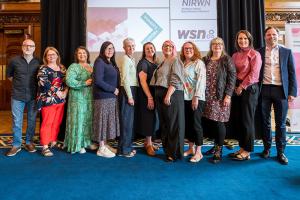
“It’s not just about remembering – it’s about activating. This isn’t a static archive: it’s a digital educational ecosystem built for the future and to inspire future action.”
Sarah Stack’s powerful words encapsulate the ambition behind the newly launched Pillars for Peace-Building digital toolkit.
Unveiled at Belfast City Hall on 27 May 2025, the resource marks a pivotal moment in acknowledging women’s profound, yet often overlooked, contributions to peace and security in Northern Ireland.
Unearthing Untold Histories
For too long, the official narratives of peacebuilding in the region have largely overlooked the vital contributions of women. As Charmain Jones, Women’s Spaces Co-ordinator and co-creator of the toolkit, explained: “Official histories have focused on political leaders and paramilitary actors, overlooking the crucial grassroots work led by women throughout the Troubles and beyond.”
Pillars for Peace-Building aims to shine a light on over a century’s worth of women’s contributions.
Charmain believes this groundbreaking resource uniquely addresses key historical gaps.
She said: “It highlights how women, often outside formal political structures, served as community mediators, organised across sectarian lines, and supported families devastated by conflict.”
By centring the stories of working-class women, civic activists, trade unionists, rural women, and other marginalised voices, the toolkit reframes peace, as Charmain stated, “not as a top-down achievement but as a collaborative and deeply human process.” This approach ensures that women’s contributions are no longer hidden footnotes but recognised as foundational pillars in building and sustaining peace.
Bridging Generations
Twenty-seven years have passed since the Good Friday Agreement – nearly a generation. Yet, as Charmain noted, “many of the women who built peace at community and political levels remain absent from the public memory.”
This growing urgency was a key driver to preserve and share these stories before they were lost to time.
“Many younger people today have little lived memory of the Troubles or the grassroots activism that underpinned the peace process,” she said. “Now is the time to ensure these stories are visible, valued, and passed on, so they can inspire future peacebuilders in Northern Ireland and beyond.”
Sarah, who has over a decade of experience within the women's sector in NI, added, "This toolkit is both a tribute and an offering – a way of making sure that legacy isn't lost." Personally, the development of the toolkit has reenforced her long-standing appreciation of the power of women’s stories, and provided the opportunity to reveal the many trailblazing women whose stories were untold.
Diverse Voices and Shared Ownership
Pillars for Peace-Building was developed by the Women’s Spaces team in conjunction with four key partner organisations. This collective approach has created a resource that genuinely reflects the diverse experiences of women throughout the region.
“By grounding the toolkit in partnership,” she said, “it moves beyond symbolic recognition to a living, breathing archive of women’s peace work.”
This approach, it is hoped, should ensure that the toolkit presents a rich tapestry of unique voices.
Reinforcing this, Sarah highlighted that the resource “was co-developed with rural, migrant, LGBTQ+, and disabled women, ensuring a strong foundation of inclusion and relevance.”
She added: “That inclusive process shaped not just the content, but also the tone and usability of the toolkit. It’s not just about sharing information; it’s about making people feel seen, heard, and included.”
Mobile Phone Video Approach
The team embraced a remarkably pragmatic approach to capturing stories on video.
“We didn’t set out to be filmmakers,” Sarah said, “we just knew these stories needed to be heard.”
They didn’t let a lack of filmmaking equipment get in the way of telling the stories they needed to be told. Their setup was simple yet effective: a mobile phone; a TikTok light; a basic mic; and free software like OBS Studio.
“You don’t need expensive equipment to tell powerful stories,” Sarah explained. “You need intention, respect, and a commitment to listening.”
To further enhance accessibility, each video also contains subtitles.
Future Impact
Pillars for Peace-Building was envisioned as a catalyst for continued action, as well as a blueprint for inclusive, community-led peace work.
Charmain said: “It bridges past and present, showing that peace is not a one-time achievement, but an ongoing process requiring care, courage, and collective effort.”
Both Charmain and Sarah were driven by a deep personal commitment to ensuring women’s voices are heard, honoured, and preserved for future generations.
With this in mind, it is hoped that the toolkit will empower new peacebuilders and reignite cross-community solidarity.
As Sarah powerfully concluded, “I hope it inspires connection – between generations, across communities, and with global movements. Most of all, I hope it reminds us that peace is not a finished product: it’s a process that must include, and be shaped by, women. Always.”
Further Info
The Pillars For Peace-Building toolkit is available here: www.pillarsforpeace.org